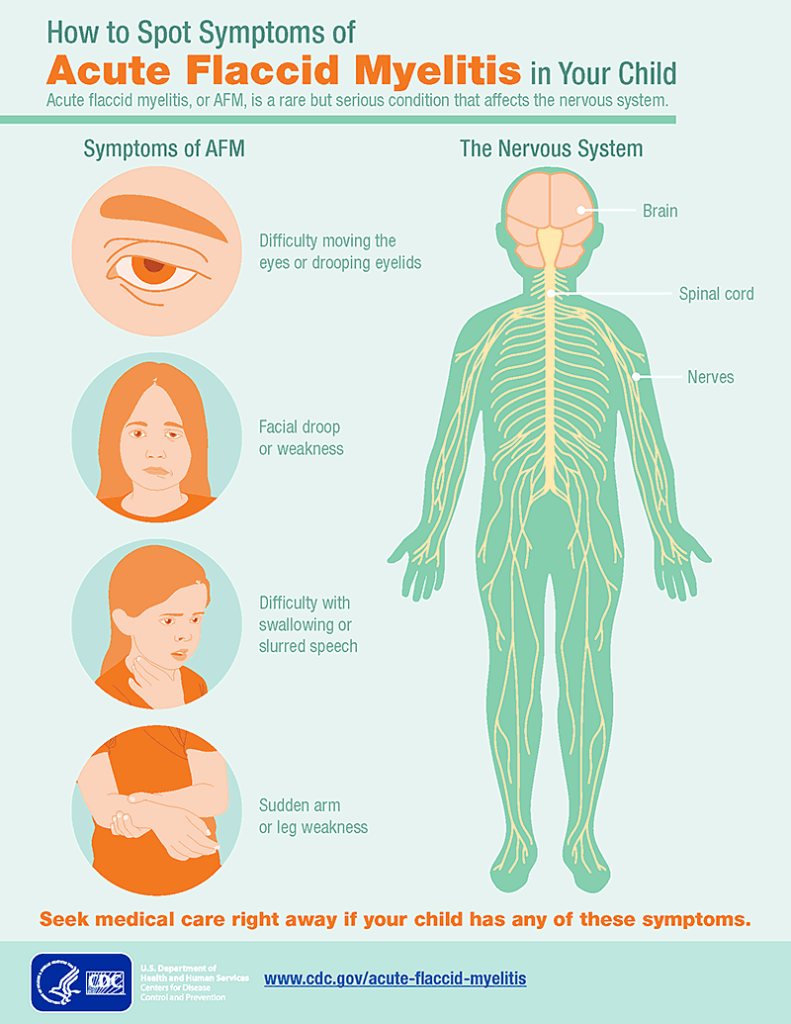Facts about Acute Flaccid Myelitis from CDC
Acute flaccid myelitis (AFM) is a rare but serious condition. It affects the nervous system, specifically the area of spinal cord called gray matter, which causes the muscles and reflexes in the body to become weak.
This condition is not new, but the increase in cases that the US saw starting in 2014 is new. It is also interesting that the outbreak has happened in a state where the anti vaccine lobby has been particularly active. Minnesota saw a visit from Andrew Wakefield – a former British doctor who is a staunch opponent of vaccination – some time back.
CDC estimates that less than one in a million people in the United States will get AFM every year. There are a variety of possible causes of AFM, such as viruses, environmental toxins, and genetic disorders. Most of the cases that CDC has learned about have been in children.
Symptoms
Most have sudden onset of arm or leg weakness and loss of muscle tone and reflexes. Some people, in addition to arm or leg weakness, will have:
- Facial droop/weakness,
- Difficulty moving the eyes
- Drooping eyelids, or
- Difficulty with swallowing or slurred speech.

Numbness or tingling is rare in people with AFM, although some people have pain in their arms or legs. Some people with AFM may be unable to pass urine.
The most severe symptom of AFM is respiratory failure that can happen when the muscles involved with breathing become weak. This can require urgent ventilator support. In very rare cases, it is possible that the process in the body that triggers AFM may also trigger other serious neurologic complications that could lead to death.
If you or your child develops any of these symptoms, you should seek medical care right away. Your doctor may collect information about your symptoms and send this information to their health departments. This is because CDC is asking doctors to be alert for patients with symptoms of AFM so that we can learn more about this condition.
Diagnosis
AFM is diagnosed by examining a patient’s nervous system in combination with reviewing pictures of the spinal cord. A doctor can examine a patient’s nervous system and the places on the body where he or she has weakness, poor muscle tone, and decreased reflexes. A doctor can also do an MRI (magnetic resonance imaging) to look at a patient’s brain and spinal cord, do lab tests on the cerebrospinal fluid (the fluid around the brain and spinal cord), and may check nerve conduction (impulse sent along a nerve fiber) and response. It is important that the tests are done as soon as possible after the patient develops symptoms.
AFM can be difficult to diagnose because it shares many of the same symptoms as other neurologic diseases, like transverse myelitis and Guillain-Barre syndrome. With the help of testing and examinations, doctors can distinguish between AFM and other neurologic conditions.
For parents who have a child with AFM
AFM is a serious condition that can be difficult for children and their parents or caregivers. You are in the best position to be an advocate for your child. Talk to the doctor about any discomfort your child may have and ask about treatment options. Ask your child’s school about resources they may have to accommodate this illness. Spending time with others is also an important part of wellbeing and recovery. Encourage friends and family to spend time with your child if they feel well enough for visitors.


